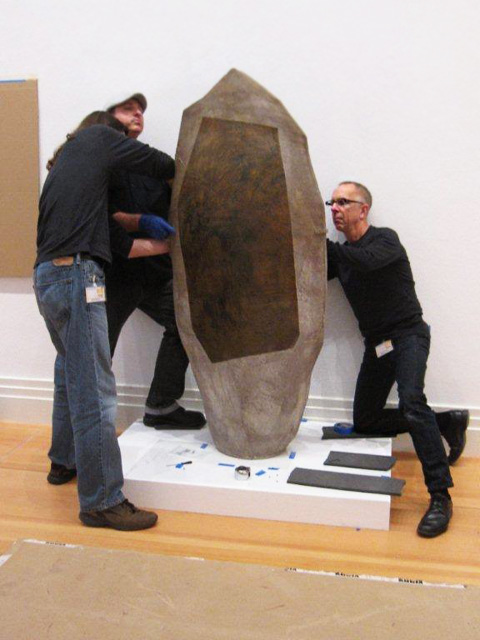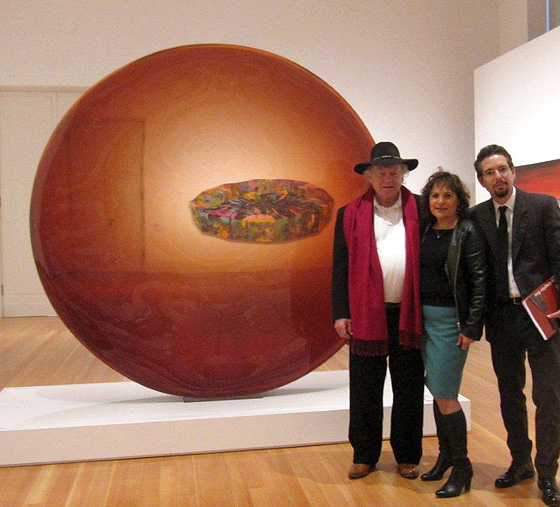
PSTinBerlin: The Martin-Gropius-Bau in Berlin, with the Kunst in Los Angeles banner flying high (at right)
Pacific Standard Time officially ended in Los Angeles on March 31, but it continues nearly 6,000 miles away in Berlin.
Pacific Standard Time: Kunst in Los Angeles 1950–1980 opened at the Martin-Gropius-Bau in Berlin on March 15th. With double the space of the Getty Center exhibitions Crosscurrents in L.A. Painting and Sculpture and Greetings from L.A.: Artists and Publics—which we curated with our GRI colleagues Glenn Phillips and Catherine Taft—and with many new works added, the show was reconceived for the German venue.

Conservators and preparators from the J. Paul Getty Museum install John Mason’s 1957 sculpture Vertical Sculpture, Spear Form at the Martin-Gropius-Bau. Artwork © John Mason

L.A. art under Berlin skies: crated artwork gets a lift into the galleries of the Martin-Gropius-Bau.
Entering the Martin-Gropius-Bau galleries, you leave 21st-century Berlin behind and enter Los Angeles of the ‘60s and ‘70s. Visitors are greeted by a large-scale version of Louis Hock’s three-channel film installation Southern California and Ed Ruscha’s 18-foot-long artist’s book Every Building on the Sunset Strip splayed out in a vitrine. A selection of Dennis Hopper’s photographs dots the walls nearby, giving a flavor of the L.A. sensibility.
Major new additions for the Berlin presentation include Sam Francis’s monumental 24-by-36-foot painting Berlin Red, which was painted in Los Angeles as a commission for the Neue Nationalgalerie in 1969, and Edward Kienholz’s series of sculptures Volksempfängers (People’s Wireless), which are installed in the Schliemann Saal room, a gallery that originally housed archeologist Heinrich Schliemann’s discovery of Trojan gold and other spoils in the late 19th century.
Single-artist galleries are devoted to the work of James Turell, Robert Graham, Larry Bell, and Bruce Nauman, and 50 Julius Shulman photographs supplement the exhibition, giving visitors a taste of the Los Angeles built environment.
The exhibition was positively reviewed in the German and European media, and while some critics fell back on the oft-repeated cliches of “California cool,” many offered meaningful reappraisals of art made in Southern California in the postwar era.
And the visitors to the show? Many were drawn in by David Hockney’s idealized notion of sunny California and its swimming pools, but almost as many were intrigued by the work of lesser-known artists such as De Wain Valentine and Ron Davis.

Artist De Wain Valentine with Rani and Andrew in the Martin-Gropius-Bau galleries, in front of Valentine’s monumental polyester resin sculpture Red Concave Circle. Artwork © De Wain Valentine.

Artist Fred Eversley with Andrew at the Martin-Gropius-Bau
We were part of a large contingent of Angelenos in Berlin for the opening, which included many of the artists, such as Charles Arnoldi, Larry Bell, Judy Chicago, Ed Moses, and Fred Eversley. A lively artists’ panel moderated by Research Institute curator Rani Singh gave the audience a sense of the personalities and long-shared histories of the group. The California contingent was also treated to a behind-the-scenes tour of Berlin’s Museuminsel (Museum Island) by Peter Klaus Schuster, director emeritus of the Berlin State Museums, and Research Institute director Thomas Gaehtgens. Both art historians contributed essays to the new German publication Pacific Standard Time: Kunst in Los Angeles 1945–1980.
Berlin has been Los Angeles’s sister city since 1967, and the two metropolises share a spirit of artistic energy and a legacy of fearless experimentation. It’s the perfect place for Pacific Standard Time to continue its journey.




Comments on this post are now closed.
Trackbacks/Pingbacks